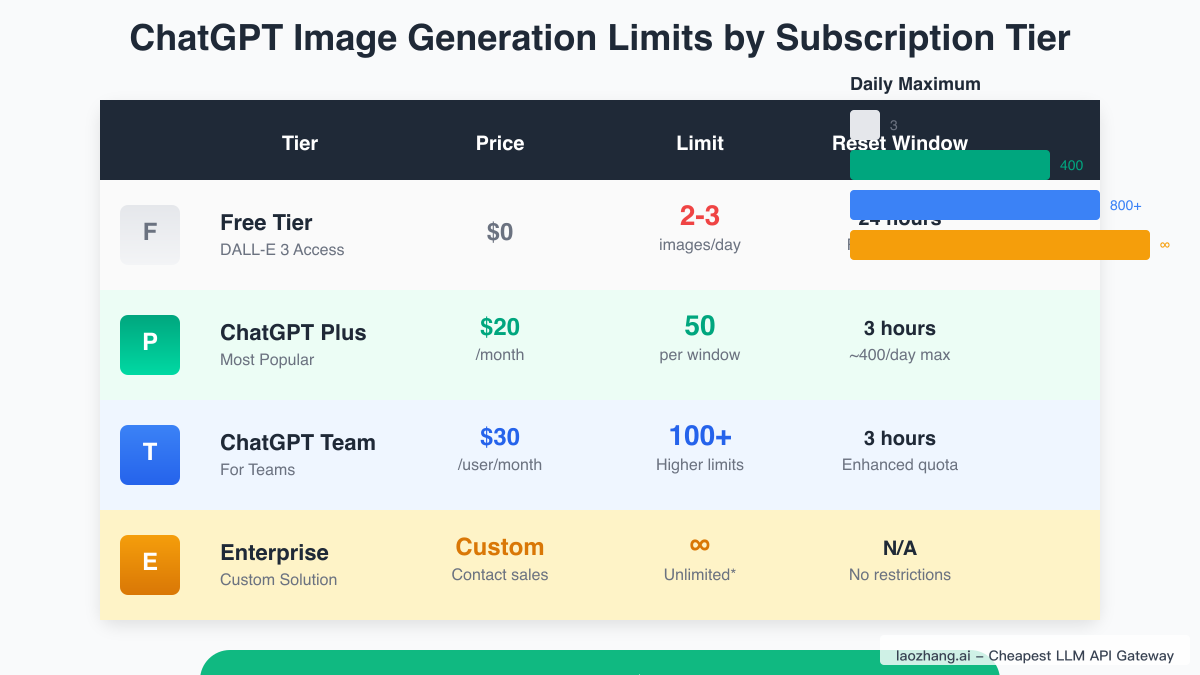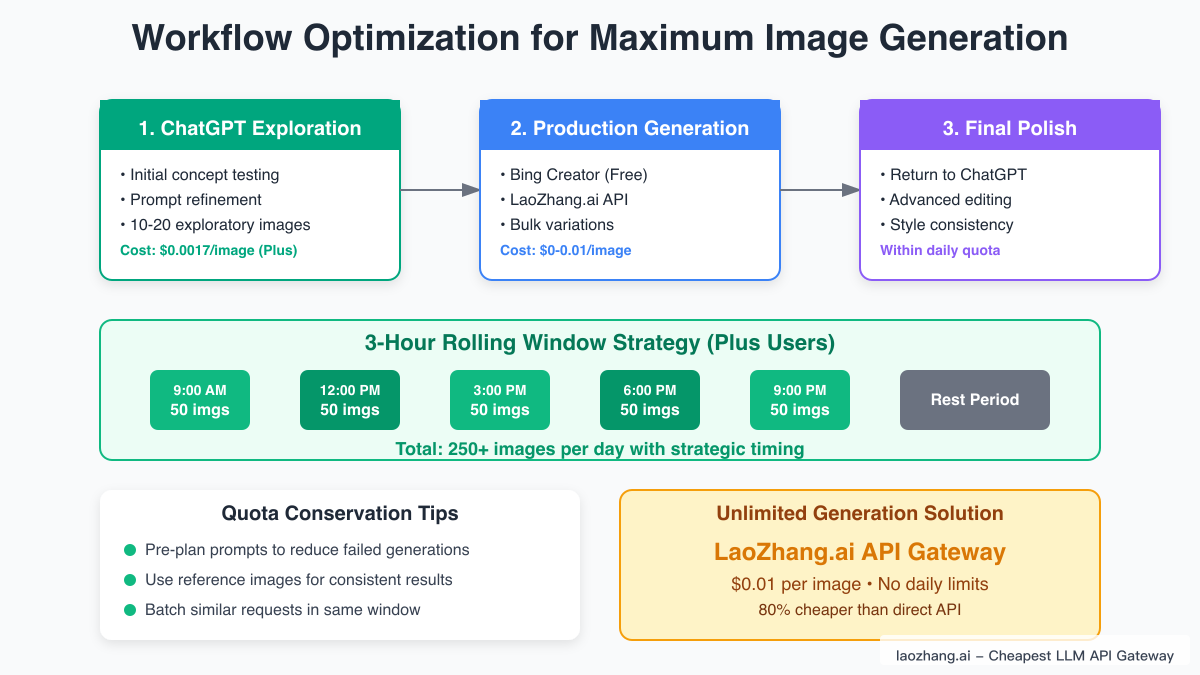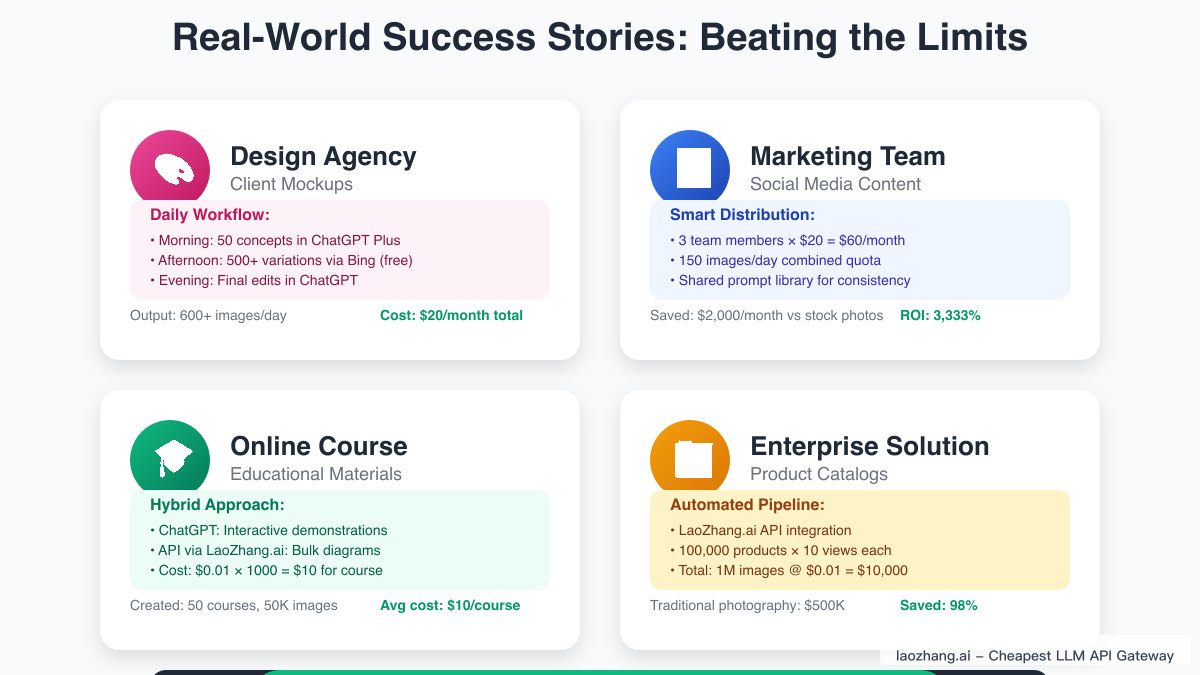The frustration hits at the worst possible moment—you're in the creative flow, generating stunning DALL-E 3 images through ChatGPT, when suddenly the dreaded message appears: "You've reached your image generation limit." This universal experience among ChatGPT users has sparked countless forum discussions, support tickets, and creative workarounds as users struggle to understand exactly when their precious image generation quota will reset. The confusion is compounded by OpenAI's rolling window system, documentation discrepancies, and the significant gap between advertised capabilities and actual limits.
Since DALL-E 3's integration into ChatGPT and its subsequent availability to free users in August 2024, millions have discovered the power of AI image generation. Yet the journey from prompt to picture is often interrupted by mysterious limits that seem to change without notice. Free users report anywhere from 2 to 3 daily images, while Plus subscribers expecting hundreds based on documentation find themselves capped at 50 images every three hours. This comprehensive guide cuts through the confusion to reveal exactly how ChatGPT's image generation limits work, when they reset, and most importantly, how to maximize your creative output within these constraints.
Understanding the Rolling Window: Why There's No Midnight Reset
The most fundamental misconception about ChatGPT's image generation limits centers on reset timing. Unlike traditional daily limits that refresh at midnight, ChatGPT employs a sophisticated rolling window system that tracks individual usage patterns. This means your image generation quota doesn't magically replenish when the clock strikes twelve—instead, each generated image starts its own countdown timer that expires after a specific duration.
For free tier users, this rolling window spans 24 hours from the moment of generation. If you create your first image at 9:15 AM on Monday, that specific image's quota slot becomes available again at exactly 9:15 AM on Tuesday. This individual tracking system means users who space out their generations throughout the day maintain a more consistent creative workflow than those who exhaust their quota in rapid succession. The system's elegance lies in its fairness—preventing rush-hour server overloads while ensuring equitable access across time zones.
ChatGPT Plus subscribers benefit from a more generous 3-hour rolling window, allowing up to 50 images per period. This shorter window enables power users to generate up to 400 images daily if they strategically distribute their usage across eight 3-hour blocks. However, the reality of creative workflows rarely aligns with such rigid scheduling. Most Plus users find themselves generating images in bursts, then waiting for the rolling window to release additional quota. The key insight here is understanding that each image generation triggers its own 3-hour timer, creating a complex web of overlapping windows that requires careful management for optimal utilization.
The Reality of Current Limits: Free vs Plus vs Team vs Enterprise

The stratification of image generation limits across ChatGPT's subscription tiers reveals OpenAI's delicate balance between accessibility and sustainability. Free tier users, granted access to DALL-E 3 in August 2024, receive 2-3 images per rolling 24-hour period. While this might seem restrictive, it represents a significant democratization of AI image generation technology that was previously locked behind paywalls. These free generations utilize the same powerful DALL-E 3 model as paid tiers, producing 1024x1024 pixel images with remarkable detail and coherence.
ChatGPT Plus, at $20 monthly, dramatically expands creative possibilities with 50 images per 3-hour rolling window. This translates to a theoretical maximum of 400 daily images for users who perfectly time their generations. However, real-world usage patterns typically yield 100-200 images daily, as creative sessions rarely align with optimal window management. Plus subscribers also gain access to additional features like image editing within ChatGPT, style consistency tools, and priority processing during high-demand periods. The value proposition becomes clear when comparing the per-image cost: at maximum utilization, Plus users pay approximately $0.0017 per image—a fraction of direct API pricing.
Team and Enterprise tiers operate in a different realm entirely, with OpenAI remaining deliberately vague about specific limits. Team accounts at $30 per user monthly offer "higher limits" than Plus, while Enterprise customers reportedly enjoy "unlimited" access to DALL-E 3 generation. This opacity serves multiple purposes: it allows OpenAI to dynamically adjust limits based on infrastructure capacity, prevents abuse through clearly defined quotas, and maintains flexibility for custom enterprise agreements. Anecdotal reports from Team users suggest limits around 100-150 images per 3-hour window, while Enterprise customers report no practical limitations on their creative output.
Documentation vs Reality: The 500 Images Per Minute Myth
Perhaps no aspect of ChatGPT's image generation system causes more frustration than the dramatic discrepancy between documented capabilities and actual limits. OpenAI's official API documentation prominently displays rate limits of 500 to 7,500 images per minute for various paid tiers—numbers that paint a picture of virtually unlimited creative potential. Yet users consistently report actual limits of 7-15 images per minute, creating a credibility gap that undermines trust and complicates capacity planning for businesses building on the platform.
This documentation disconnect stems from multiple factors that OpenAI has been slow to address. The published numbers likely represent theoretical infrastructure capacity rather than practical limits imposed for quality control and fair usage. Additionally, the documentation may reflect API capabilities that differ from ChatGPT interface restrictions, though even direct API users report similar throttling. The situation is further complicated by dynamic rate limiting that adjusts based on system load, time of day, and individual account behavior patterns.
The practical impact of this documentation failure ripples through the creative community. Freelance designers budget project timelines based on advertised capabilities, only to discover their workflows grinding to a halt. Marketing agencies promise clients rapid iteration on visual concepts, then scramble to explain unexpected delays. Educational institutions planning curriculum around AI tools find lesson plans disrupted by unanticipated limits. The lesson here isn't just about number accuracy—it's about the critical importance of setting realistic expectations in rapidly evolving technological landscapes.
The Hidden Costs: When Failed Generations Count Against Your Limit
One of the most frustrating aspects of ChatGPT's image generation system lies in how it counts attempts rather than successes. Every time you click that generate button, regardless of outcome, your quota takes a hit. This means network timeouts, server errors, content policy flags, and user-initiated cancellations all consume precious generation slots without delivering usable images. For free users with only 2-3 daily images, a single failed generation represents a significant portion of their creative capacity.
The technical rationale behind counting failed attempts makes sense from an infrastructure perspective—computational resources are consumed regardless of outcome. However, the user experience suffers when creative exploration is penalized by technical limitations. Common failure scenarios include overly complex prompts that exceed processing capabilities, network interruptions during the 10-30 second generation window, and content filters triggering on benign requests due to keyword false positives. Each failure not only wastes a generation slot but also disrupts creative momentum and forces users to second-guess their approach.
Savvy users have developed strategies to minimize failed generations, treating each attempt as a valuable resource requiring careful consideration. This includes crafting detailed but not overly complex prompts, avoiding ambiguous language that might trigger content filters, and waiting for complete generation before navigating away from the page. Some users report success with "prompt testing" in other free tools before committing to ChatGPT generation, while others maintain spreadsheets of successful prompt formulas to ensure consistent results. The emergence of these workarounds highlights a fundamental truth: when artificial scarcity is imposed on digital resources, user behavior adapts in ways that may actually increase overall system complexity.
Maximizing Your Daily Quota: Strategies from Power Users

The ChatGPT power user community has evolved sophisticated strategies for extracting maximum value from limited generation quotas. These techniques, refined through countless hours of experimentation, transform the frustrating limit system into a manageable creative framework. The foundation of quota optimization rests on understanding that quality trumps quantity—a single well-crafted prompt yielding the desired result proves more valuable than multiple iterations chasing an unclear vision.
Prompt engineering emerges as the critical skill for quota conservation. Successful practitioners begin with comprehensive mental visualization before touching the generate button. They incorporate specific details about composition, lighting, style, and mood in their initial prompt rather than relying on iterative refinement. This front-loaded approach might spend an extra minute crafting the perfect prompt but saves multiple generation attempts. Advanced users maintain personal prompt libraries, documenting successful formulas for common image types and styles. These libraries become invaluable resources, reducing failed generations while accelerating creative workflows.
Timing strategies play an equally crucial role in quota optimization. Plus subscribers who understand the 3-hour rolling window schedule their creative sessions accordingly. Rather than exhausting 50 images in rapid succession, they space generations across the window period, maintaining a steady flow of available quota. Some users set timer reminders at 3-hour intervals, triggering focused generation sessions that maximize each window's potential. Others adopt a "batch and wait" approach, generating multiple variations of priority images during one window, then shifting to other tasks while quota regenerates. This rhythmic workflow aligns natural creative cycles with technical limitations, reducing frustration while maintaining productivity.
Alternative Gateways: Bing, API, and the $0.01 Solution
When ChatGPT's limits prove insufficient, the broader AI image generation ecosystem offers compelling alternatives. Bing Image Creator stands out as the most accessible option, providing free access to the same DALL-E 3 model that powers ChatGPT. With 99 daily "boosts" for fast generation and unlimited slow generations thereafter, Bing effectively removes the scarcity that plagues ChatGPT users. The interface may lack ChatGPT's conversational refinement, but for pure generation volume, Bing delivers unmatched value.
Direct API access presents another path for users requiring programmatic control or higher volumes. At $0.04 per standard image, the API initially appears expensive compared to ChatGPT Plus's effective $0.0017 per image rate. However, the API's lack of daily limits and consistent availability make it attractive for commercial applications. Businesses can generate thousands of images on demand, integrate generation into automated workflows, and maintain predictable costs without worrying about rolling windows or mysterious quota resets. The trade-off between higher per-image costs and operational flexibility often favors API access for serious users.
LaoZhang.ai emerges as the optimal middle ground, offering DALL-E 3 generation at just $0.01 per image—80% cheaper than direct API access. This dramatic cost reduction comes without sacrificing quality or imposing restrictive limits. Users report consistent 100 requests per minute capabilities, far exceeding ChatGPT's practical limits. The platform's multi-model support means users can seamlessly switch between DALL-E 3, Stable Diffusion, and Midjourney APIs using unified billing and management interfaces. For creative professionals and businesses seeking to scale their AI image generation without breaking budgets, LaoZhang.ai's gateway service represents a game-changing value proposition that sidesteps ChatGPT's artificial limitations entirely.
Real-World Workflows: How Professionals Navigate the Limits
Professional creatives have developed sophisticated workflows that treat ChatGPT's limits as just one component in a broader AI-powered toolkit. Successful practitioners begin their creative process with ChatGPT Plus, leveraging its conversational interface for initial concept exploration and prompt refinement. The ability to iteratively discuss and refine ideas with ChatGPT, viewing generated images in context, provides unmatched creative flow during the ideation phase. These initial 50 images per window serve as creative reconnaissance, exploring style directions and compositional approaches.
Once core concepts crystallize, professionals seamlessly transition to higher-volume platforms for production work. A typical workflow might generate 10-20 exploratory images in ChatGPT, identify the most promising directions, then shift to Bing Image Creator or LaoZhang.ai for generating multiple variations and final assets. This hybrid approach maximizes each platform's strengths: ChatGPT for intelligent iteration, Bing for free volume, and LaoZhang.ai for cost-effective quality at scale. The key insight is that no single platform needs to serve every need—strategic platform selection based on project phase optimizes both cost and creative output.
Marketing agencies have formalized these workflows into standard operating procedures. Initial client consultations happen within ChatGPT, where the conversational interface helps translate vague creative briefs into concrete visual directions. Once clients approve general concepts, production shifts to high-volume platforms for generating campaign assets. Final refinements might return to ChatGPT for its superior editing capabilities. This circular workflow, moving fluidly between platforms based on specific needs, demonstrates how artificial limitations can actually improve creative processes by forcing intentional decision-making at each stage.
The Psychology of Limits: Why Scarcity Might Actually Help

Counterintuitively, ChatGPT's restrictive limits may enhance rather than hinder creative output for many users. The psychological principle of constraint-induced creativity suggests that limitations force more thoughtful, deliberate approaches to problem-solving. When each image generation carries weight, users invest more effort in prompt crafting, visual planning, and outcome evaluation. This forced intentionality often produces superior results compared to unlimited systems where users might generate hundreds of mediocre images hoping for accidental success.
The scarcity mindset activated by generation limits parallels proven productivity techniques like time-boxing and the Pomodoro method. Just as artificial time constraints can enhance focus and efficiency, image generation limits create natural boundaries that prevent creative rabbit holes. Users report spending less time on endless iterations and more time on strategic planning and post-generation refinement. The 3-hour window for Plus users creates natural break points that combat creative fatigue and encourage reflection on generated work. This rhythmic cycle of generation, evaluation, and strategic planning often yields better final outputs than marathon generation sessions.
Educational contexts particularly benefit from these constraints. Teachers using ChatGPT for visual aid creation find that limits encourage students to think critically about their requests rather than taking a "spray and pray" approach. The need to carefully consider each generation teaches valuable lessons about resource management, strategic planning, and quality over quantity. Students learn to articulate their visual needs precisely, developing communication skills that transfer beyond AI tools. In this light, ChatGPT's limits transform from frustrating barriers into valuable pedagogical tools that enhance learning outcomes.
Future Outlook: Will Limits Increase or Disappear?
The trajectory of AI image generation limits remains uncertain, pulled between competing forces of democratization and sustainability. OpenAI's infrastructure investments and efficiency improvements suggest potential for increased limits, while explosive user growth and computational demands argue for maintaining or even tightening restrictions. The August 2024 expansion of DALL-E 3 to free users demonstrates OpenAI's commitment to accessibility, yet the modest 2-3 image daily limit reveals the economic realities of providing cutting-edge AI capabilities at scale.
Market competition will likely prove the decisive factor in limit evolution. As alternative platforms offer more generous quotas or unlimited generation, OpenAI faces pressure to remain competitive. The emergence of open-source alternatives like Stable Diffusion and aggressive pricing from services like LaoZhang.ai creates a race toward abundance that benefits end users. We may see ChatGPT adopt more nuanced limit structures, perhaps offering unlimited lower-quality generations while maintaining quotas for premium outputs. Dynamic pricing models that allow users to purchase additional generations on demand could provide flexibility while maintaining base tier affordability.
The long-term vision points toward AI image generation becoming as commonplace as text search—unlimited, instant, and taken for granted. However, this future requires dramatic improvements in efficiency, infrastructure, and business models. Until then, users must navigate the current reality of limits, resets, and workarounds. The winners in this transitional period will be those who master multi-platform workflows, leveraging each service's unique strengths while minimizing their limitations. Whether through ChatGPT's conversational interface, Bing's free abundance, or LaoZhang.ai's affordable API access, the tools for unlimited creativity exist—they just require strategic assembly.
Conclusion: Mastering the Art of Limited Resources
Understanding ChatGPT's image generation limits and reset times transforms frustration into strategic advantage. The rolling window system, while initially confusing, provides predictable access patterns that enable planned creative workflows. Free users can maximize their 2-3 daily images through careful prompt engineering and strategic timing. Plus subscribers unlock significant creative potential with 50 images per 3-hour window, sufficient for most individual needs when properly managed. Team and Enterprise tiers offer expanded capabilities for organizational requirements.
Yet the most successful users recognize that ChatGPT represents just one option in an expanding ecosystem of AI image generation tools. By combining ChatGPT's conversational strengths with Bing's free volume and LaoZhang.ai's affordable API access, creatives can achieve virtually unlimited generation capacity at minimal cost. The key lies in selecting the right tool for each project phase: ChatGPT for exploration, alternative platforms for production, and API services for automation and scale.
As AI image generation technology continues its rapid evolution, today's limits will inevitably seem quaint. Until that abundant future arrives, mastering current constraints through strategic platform selection, workflow optimization, and smart resource management ensures your creative vision never hits a hard stop. Whether you're a solo creator working within free tier limits or an enterprise seeking to scale visual content production, understanding these systems empowers you to push boundaries while respecting boundaries. Start optimizing your workflow today, and transform ChatGPT's limits from creative constraints into catalysts for innovation.
Access Unlimited DALL-E 3 Generation at $0.01 Per Image - Start with LaoZhang.ai
